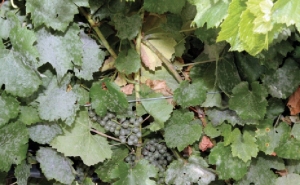
Grape powdery mildew is easily seen in these vines that are part of Washington State University’s 1.5-acre research vineyard. Outside rows of the Chardonnay and Riesling vineyard have never been sprayed for mildew, creating a pathologist’s dream for mildew incidence. (Melissa Hansen/Good Fruit Grower)
Grape powdery mildew in the Pacific Northwest is an ongoing problem in wine grape vineyards; grape powdery mildew research is also ongoing. For nearly two decades, Washington State University researchers have conducted fungicide efficacy trials, screening hundreds of products.
In the early 1990s, Washington State University pathologist Dr. Gary Grove planted a small fungicide evaluation vineyard to study experimental and registered products, their rates, and timing of application.
Dr. Michelle Moyer, WSU extension viticulturist, gave a tour of the fungicide plot during a WSU grape field day last summer.
“When it comes to powdery mildew and Botrytis bunch rot, Chardonnay and Riesling are the ‘white rats’ in the Vitis vinifera world,” Moyer said. “Those two cultivars were selected for the trial because if a grape plant is going to get powdery mildew, those are the two that will get it.”
Chardonnay and Riesling are also susceptible to Botrytis bunch rot, allowing Grove to study efficacy against bunch rot in the same block.
The outside rows of the 1.5-acre block have never been sprayed for powdery mildew or bunch rot control.
“So, we have our very own naturally occurring disease, and we don’t need to inoculate the vines with a fungus or pathogen,” she said. In years of high disease pressure, the efficacy trial shows disease symptoms several weeks before commercial vineyards in Yakima Valley.
Irrigation
Multiple irrigation drip lines are included in the block so researchers can add extra water to encourage disease, if needed. Also, a weather station that is part of WSU’s statewide AgWeatherNet system is located next to the trial and provides accurate data to help researchers develop and fine-tune disease models.
Throughout the season, fruit and foliage are evaluated for disease severity and phytoxicity. Researchers want to know if the product controls disease on the fruit or foliage, or both. Hooded sprayers are used to minimize drift.
In 2013, more than 34 fungicide treatments were evaluated.
WSU scientists typically apply five to six fungicide sprays in a growing season, starting when shoots are 10 to 15 inches long.
“For powdery mildew control for fruit, we usually spray early in the season at prebloom, 50 percent bloom, fruit set, and then it depends on the weather if we spray more,” said Moyer. “We almost always stop applications around four weeks after bloom.”
For control on foliage, an additional early spray is applied and a few later if researchers are looking at Botrytis bunch rot control. Timing is everything in a powdery mildew control program.
“Most people spray too early and continue to spray too late,” she said. “If you’re having continual difficulty controlling mildew, you may need to consider if you have the right match of tractors and sprayers for your acreage.”
Although some growers apply dormant applications of lime sulfur to target overwintering cleistothecia, Moyer discouraged such applications. Dormant applications can help in areas with high levels of trunk diseases like eutypa and phomopsis, but for powdery mildew, the rates that are needed to be effective are much higher than the label allows.
“It’s always good to do your own spray trials if you are trying a new material,” she said during the field day. “On-farm spray trials are easy to set up, but the key is to have a control within your vineyard so you have something to compare the new treatment to.”
WSU has developed powdery mildew bulletins to help eastern and western Washington grape growers manage the disease. Bulletins contain a fungicide list of registered fungicides, active ingredients, fungicide class, fungicide grouping, mildew efficacy, and resistance risk. Such information is useful in developing fungicide resistance management programs.
Fungicide lists are updated annually in WSU’s Grape Pest Management Guide, a publication available as a download or hard copy. •
The grape powdery mildew bulletins can be found at http://wine.wsu.edu/research-extension/plant-health/grape-diseases/. The 2014 Grape Pest Management Guide is available at https://pubs.wsu.edu.

Leave A Comment